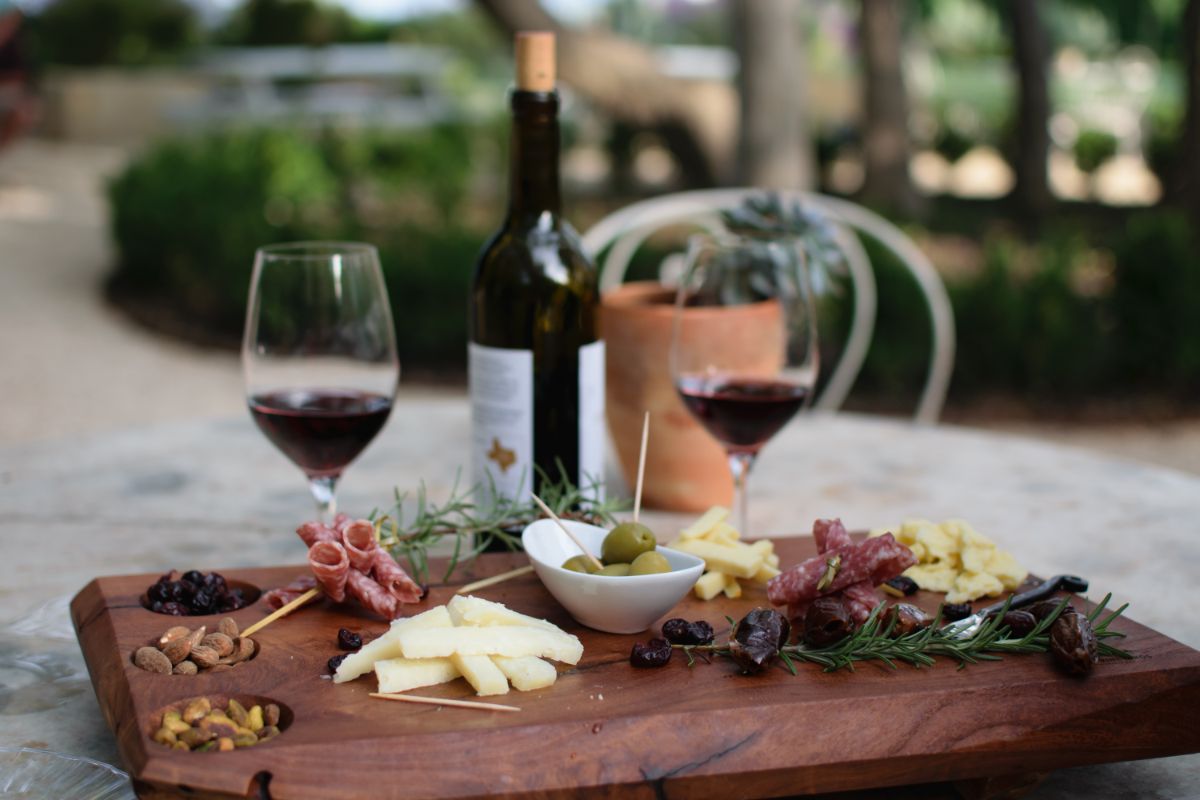Italian Primitivo wines are very unique, being famous throughout Italy for their beautiful crimson tones, very high alcohol content, and dulcet complexions.
The grape gets its name due to the early ripening of the grape variety and it is grown in the Manduria region in Southern Italy.

If you’re interested in finding out all about the Primitivo grape, you’ve come to the right place!
We’ve compiled an ultimate guide to the delicious wine, giving you all the information you need to become a connoisseur on the topic. Let’s dive in!
What Is Primitivo?
Primitivo is a dark-skinned grape that produces wine that is high in tannins. It has a very intense flavor, and the dark color of the grape means that it is very high in tannins and alcohol.
The wine produced using this grape usually reaches 18%. This can be dulled in the production process, making it around 14%.
Lots of people find this wine to be quite bitter because of the high levels of tannins in the wine.
To make this wine, it will need to be left in the barrel or the bottle for a few years to ensure that it develops the way that is expected.
Primitivo translates to ‘early one’. This refers to the early ripening of the grape. This is the only meaning behind the name, as this is often mistaken by wine drinkers.
In Puglia, this wine is referred to as Mirr Test, which translates to ‘hard wine’.
Zinfandel
Zinfandel is produced from the same variety of grapes as Primitivo. Both of these grapes are grown in different weather, making them slightly different from each other.
They are also grown in different soil and are made into wine in different ways.
Primitivo variants ripen in the sun, meaning the grapes are less sweet and fruity than Zinfandel. Zinfandel is high in sugar and alcohol content, meaning the wine is much sweeter and more smooth.
These two wines are different, but they are often confused with one another. In Italy, they are never used interchangeably, but in the US, winemakers often promote their Primitivo wines using Zinfandel.
Sangiovese
Sangiovese is another completely different grape variety from Primitivo. Sangiovese grapes adopt characteristics from their environment, which means they are very similar in each region.
Primitivo grapes are much lighter in color in comparison, and they can grow in most places. Specifically, they flourish in a hot, dry climate.
Where Is Primitivo Grown?
Primitivo wine is made in the Puglia region of Italy. There are a few regions that are well-known for producing the wine. These are:
The Hills – Gioia Del Colle
This is the first place that the Primitivo grape was grown. At high altitudes, these grapes are fermented. This makes the tannins concentrated and gives the grapes much more sunlight.
Salento Peninsula
Primitivo grapes are also grown in the Salento Peninsula. Here, unique fermentation methods are used.
Taranto
Taranto is home to the most famous bottle of Primitivo wine. The soils in this area are red, and they give a crispy and acidic character to the grapes.
This makes them perfect for being exported to other places around the country or the world.
Altopiano Delle Murge
This area is vast, covering a lot of the central Puglia region. This area has very high altitudes which are ideal for producing highly concentrated Primitivo.

Characteristics Of Primitivo
Let’s take a closer look at the characteristics of Primitivo wine. This is an Italian wine that contains a moderate tannic. It is usually consumed around three to four years after harvest.
Some of the wine that is produced from Primitivo grapes are sweet wines.
The characteristics of this wine can differ because it is sometimes blended along with some other grape varieties from Italy, such as Zinfandel.
This wine has an intense flavor, an ABV of between 14 and 18 percent, high acidity, and a dark color.
Taste Of Primitivo
This wine is fruity, and it mostly contains citrus fruits and berries. These berries are zesty cherry, blackberry, raspberry, and black plum, along with many others.
There are very earthy flavors in the wine, too. These are smoke, black pepper, and licorice.
This wine is usually enjoyed while it is young, but some people like to age this wine. When it is aged, it brings out flavors of coffee, coconut, vanilla, and tobacco.
Ageability Of Primitivo
The red Primitivo grapes are ruby red but as they age, it becomes orange-red. The aroma is full and pleasant and as it ages, it becomes sweeter.
Wine made from Primitivo grapes tastes best when they are between 5 and 6 years of age. Some producers find that their wine improves after 10 to 15 years of aging. Primitivo should be aged for at least two years.
Popular Blends Of Primitivo
Winemakers have made some very interesting blends using Primitivo. Some of these interesting blends include:
Piccini Memoro Rosso
This blend includes around 40% Primitivo, 10% Merlot, 20% Nero d’Avola, and 30% Montepulciano. These grapes are all oaked in casks for 12 months before they are blended.
It creates a very pleasant aroma of figs, dark fruits, and vanilla. This is a delicious sweet red wine that is loved by everyone.
Morella Negroamaro Primitivo
This wine is deep in its color and it is grown in the Puglia region, blending Primitivo and Negroamaro grapes. This wine is aged for up to ten months, and then it is kept bottled for another 8. This allows the two wine varieties to fully integrate.
The wine that is produced in this process is smooth and rich, with intense red berry flavors.
What Food Should You Pair Primitivo With?
Primitivo is best when it is enjoyed in a certain way. The flavors in the wine are enhanced when they are paired with dishes like Spaghetti Bolognese, Pizza Rustica, and Pasta Puttanesca.
The acidity levels in this wine are fairly high, and the tannins are high, too. This makes the wine very easy to pair with certain dishes.
One dish that works very well with Primitivo is Red Pasta with Grilled Vegetables. This wine goes well with the tomato sauce, and the earthy flavors of the wine complement the charred vegetables.
Pizza Rustica also works very well with this wine. The toppings on the pizza enhance the Primitivo flavors. As well as this, the sweet tannins in wine work with the sweetness of the cheese and tomatoes.
What Temperature Should You Drink Primitivo At?
Primitivo is best when it is enjoyed at a temperature between 61 and 65 degrees Fahrenheit. This is between 16 and 18 degrees Celsius. This is a similar temperature to any other red wine.
Wine should be stored somewhere with a steady temperature, as a fluctuating temperature can have an impact on the wine.
Ensure that the wine never reaches 70 degrees Fahrenheit, as this temperature will quickly age the wine, changing the taste.

What Glass Should I Use To Drink Primitivo?
Most red wines are best served in a glass with a big bowl. This is because it gives room for the red wine to breathe, enhancing the bold flavors. The bigger bowl allows more room for oxygen to enter the glass, which is how it ‘breathes’.
Bordeaux glasses are recommended for this wine, as they are both full-bodied red wines.
These are the largest wine glasses, and they give you plenty of space between the wine and your nose for you to experience the aromatic compounds of the wine.
This site also allows the wine to flow into your palate well, meaning you will get a great tasting experience.
Making Primitivo Wine
This wine is delicious, and we bet you’re wondering how it’s made. The production of this wine is fairly straightforward, however, the production methods do have an impact on the flavors and aroma of the wine.
The only ingredients needed in this process are the Primitivo grapes, sulfur dioxide, and yeast. As Primitivo is a red wine, it is made with the skin on it. This is the only difference between white and red wine. Let’s take a look at the process!
1. Harvest The Grapes
The first stage in the process is harvesting the grapes. These grapes are ripened between late summer and early fall from the Primitivo vineyard.
The grapes are removed from their vines in branches, either by hand or using a machine. Then, any unwanted grapes, debris, and leaves are removed.
2. Crush The Grapes
The next stage in the process is crushing. The clusters of grapes are then sent to a crusher that takes the grapes off their steps and squeezes them. At this stage, winemakers often add some sulfur dioxide which minimizes oxidation.
3. Mature In Oak Barrels
These wines are then left in a tank to age before they are bottled. For high-quality red wines, it is advised that the wine is aged in oak barrels.
As the wine ages in these barrels, small bits of grape skins and sediments settle out. This will form a layer on the bottom of the barrel which is nothing to worry about.
4. FIltration
Once this process is complete, the wines are filtered. The extra sediments are then removed from the barrels, and sterile filtration is performed.
This process removes any microbes or yeast in the wine that might spoil it at a later date.
5. Bottling The Wine
The next stage in the process is putting the wine into bottles. The wine is placed in an empty bottle, labeled, and corked. It is now ready to be sold!
History Of Primitivo
Primitivo is thought to have originated in the 1700s. The grape was brought over from Croatia to Italy at this time.
During the 19th and 20th centuries, this wine was mainly used to be blended with other Italian wines.
In the 1900s, there was a call for the reduction of low-quality wines. At this time, winemakers were happy to give up the Primitivo grapes because they did not produce much income.
However, it wasn’t until the late 1990s that they found that the Zinfandel grape is identical to the Primitivo in terms of DNA analysis. This meant that they could label their Primitivo wines as Zinfandel.
This made the wine much more popular, meaning they started planting these grapes again.
Type Of Primitivo: Primitivo Di Manduria
This wine is produced in Manduria, a city in Puglia. The grapes grown in this area are famed for their luscious Primitivo wines which are grown on red soils.
This area is the only region in the country that specializes in Primitivo. The Primitivo di Manduria is produced from hand-picked grapes that are pumped and left in barrels for around 6 months.
The wine that is produced is fruity, rich, and full of texture.
Type Of Primitivo: Giola Del Colle
This wine is made in a quiet, rural town that is known for its limestone soil. This means that grapes grown in this area are less alcoholic and less acidic than in other areas.
The wine that is produced here is also distinguished by the high altitude of the vineyards which impacts the wine.
Frequently Asked Questions
Primitivo wine is also known as Zinfandel. It creates red wine, and it is the third most planted grape in certain areas of Southern Italy, including Puglia.
Final Thoughts
So, there you have it! You should now have all the information you need on Primitivo grapes. If you’ve been looking for an ultimate guide to Primitivo wine, you’re in the right place!
We have compiled all of the information you could ever want on this wine all in one place.
After reading this guide, we’re sure you’ll be an expert on Primitivo wine. There won’t be a question you can’t answer!
- Why Does Wine Taste Better With Age? - June 14, 2023
- What Does It Mean When A Bottle Of Wine Is Corked? - June 14, 2023
- Wine Fridge Vs Wine Cellar – Which One Should You Choose? - June 14, 2023
